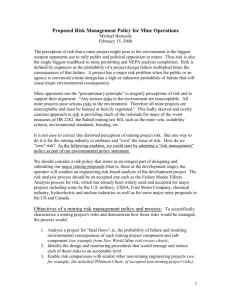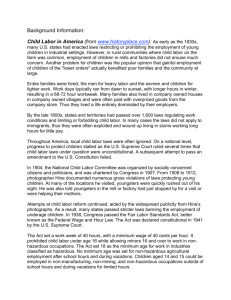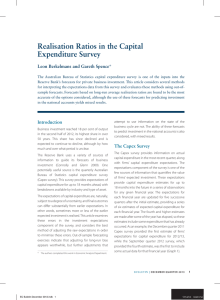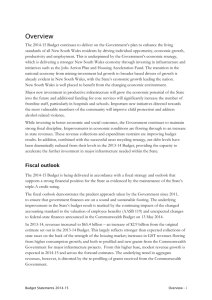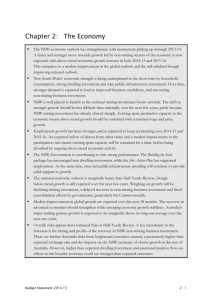Cycles in Non-mining Business Investment Stephen Elias and Craig Evans
advertisement
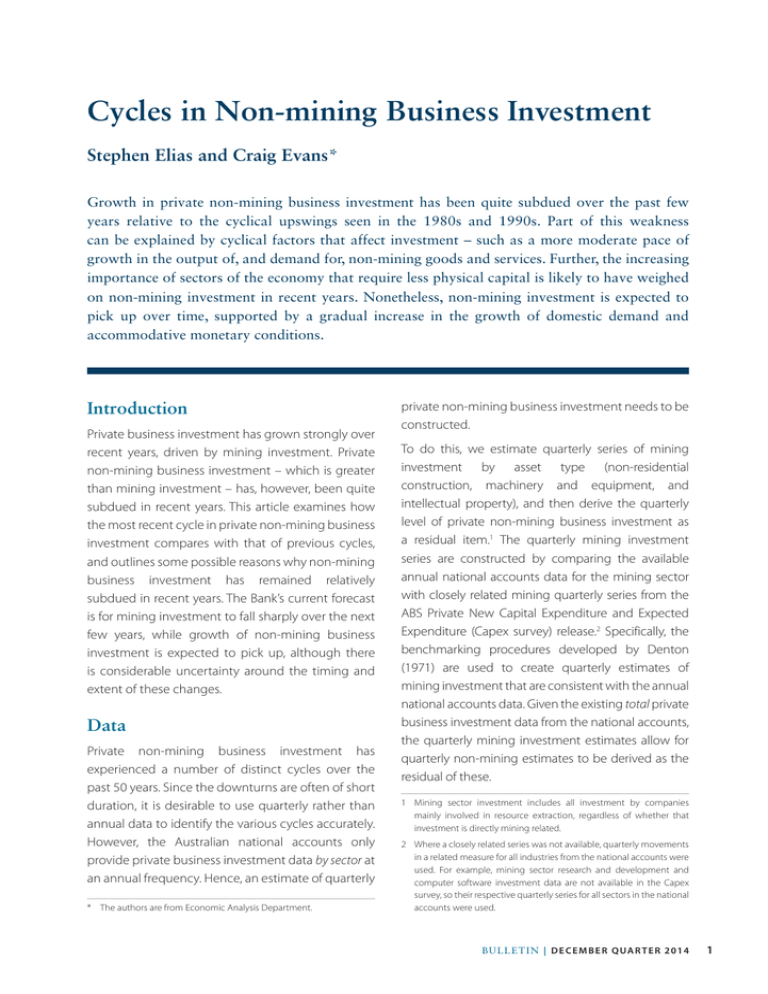
Cycles in Non-mining Business Investment Stephen Elias and Craig Evans* Growth in private non-mining business investment has been quite subdued over the past few years relative to the cyclical upswings seen in the 1980s and 1990s. Part of this weakness can be explained by cyclical factors that affect investment – such as a more moderate pace of growth in the output of, and demand for, non-mining goods and services. Further, the increasing importance of sectors of the economy that require less physical capital is likely to have weighed on non-mining investment in recent years. Nonetheless, non-mining investment is expected to pick up over time, supported by a gradual increase in the growth of domestic demand and accommodative monetary conditions. Introduction Private business investment has grown strongly over recent years, driven by mining investment. Private non-mining business investment – which is greater than mining investment – has, however, been quite subdued in recent years. This article examines how the most recent cycle in private non-mining business investment compares with that of previous cycles, and outlines some possible reasons why non-mining business investment has remained relatively subdued in recent years. The Bank’s current forecast is for mining investment to fall sharply over the next few years, while growth of non-mining business investment is expected to pick up, although there is considerable uncertainty around the timing and extent of these changes. Data Private non-mining business investment has experienced a number of distinct cycles over the past 50 years. Since the downturns are often of short duration, it is desirable to use quarterly rather than annual data to identify the various cycles accurately. However, the Australian national accounts only provide private business investment data by sector at an annual frequency. Hence, an estimate of quarterly * The authors are from Economic Analysis Department. private non-mining business investment needs to be constructed. To do this, we estimate quarterly series of mining investment by asset type (non-residential construction, machinery and equipment, and intellectual property), and then derive the quarterly level of private non-mining business investment as a residual item.1 The quarterly mining investment series are constructed by comparing the available annual national accounts data for the mining sector with closely related mining quarterly series from the ABS Private New Capital Expenditure and Expected Expenditure (Capex survey) release.2 Specifically, the benchmarking procedures developed by Denton (1971) are used to create quarterly estimates of mining investment that are consistent with the annual national accounts data. Given the existing total private business investment data from the national accounts, the quarterly mining investment estimates allow for quarterly non-mining estimates to be derived as the residual of these. 1 Mining sector investment includes all investment by companies mainly involved in resource extraction, regardless of whether that investment is directly mining related. 2 Where a closely related series was not available, quarterly movements in a related measure for all industries from the national accounts were used. For example, mining sector research and development and computer software investment data are not available in the Capex survey, so their respective quarterly series for all sectors in the national accounts were used. B u l l e tin | D E C E M B E R Q ua r t er 2 0 1 4 1 Cyc les i n N on-m i n i n g B us i n e s s I n v e s t m e n t To identify cycles in private non-mining business investment and its components, we used the Bry-Boschan quarterly (BBQ) algorithm described in Harding and Pagan (2002), adjusting the criteria to reflect the characteristics of the non-mining investment data. Broadly speaking, a trough occurs when the level of private non-mining business investment is estimated to be lower than it was in the two quarters prior to, and two quarters following, the quarter in question. This method identifies seven cycles in private non-mining business investment over the 50 years to 2013 (Graph 1). There were three downturns in the 1970s, one in the early 1980s, one in the early 1990s, and one around the time of the introduction of the GST in 2000. These align fairly closely with Australian economic recessions and/or periods of weakness in the growth of activity. The most recent trough in non-mining investment is estimated to have occurred in the March quarter 2010 following the global financial crisis. Graph 1 Private Non-mining Business Investment Volume, log scale* $b Non-residential construction 10.80 $b 10.80 Total 1.80 1.80 Machinery and equipment Intellectual property 0.30 0.30 0.05 1964 * 1974 1984 1994 2004 0.05 2014 Excluding investment in livestock and orchard growth; adjusted for second-hand asset transfers between the private and other sectors; shaded periods indicate downturn Sources: ABS; RBA We do not classify the weakness in non-mining investment since the beginning of 2013 as another downturn. While the BBQ algorithm would suggest that it is, some methods that allow for the fact that non-mining investment downturns tend to occur during periods of weakness in other observed variables suggest that it is more likely that non-mining 2 R es erv e ba nk of Aus t r a l i a investment was not in a downturn. For instance, in applying the framework used in Filardo (1994) or an adaptation of Kim and Nelson (1999, pp 124–126) to non-mining investment, the estimates suggest that there is less than 50 per cent chance that non-mining investment was in a downturn in early 2013. Cycles in Private Non-mining Business Investment It is not surprising that downturns in private non-mining business investment tend to occur at the same time as broader slowdowns in the Australian economy. Investment tends to fall more sharply than overall output during slowdowns, but then typically recovers more strongly in upswings. However, there have been more downturns in investment over the past 50 years than broader economic slowdowns and, on average, the duration of investment contractions has been slightly longer. On average, during the past 50 years, downturns in private non-mining business investment have lasted around two years and investment has contracted by 16 per cent from peak to trough (Table 1). Investment expansions, on average, have lasted around five years and seen growth of more than 70 per cent. There has, however, been considerable variation around the size of the contractions (Graph 2). The 1980s and 1990s downturns were substantial – with falls in non-mining investment of between 25 and 50 per cent – in line with the significant declines in activity in the rest of the economy during these periods. In contrast, the 1970s downturns saw falls of around 10 to 15 per cent. The most recent downturn was much smaller than the 1980s and 1990s downturns but was similar in magnitude to the declines seen in the 1970s episodes. Cycles in which downturns were larger have tended to be followed by stronger recoveries. In the 1980s and 1990s cycles, private non-mining business investment fell sharply but recovered rapidly to be more than 50 per cent higher than its trough after four years. In contrast, the decline and subsequent Cycl e s in No n - min in g B u sin e ss In ve stme n t Table 1: Non-mining Investment Cycles(a) As at 4 December 2014 Total(b) Machinery and equipment Non-residential construction Intellectual property Number of cycles since 1963 7 8 6 4 Average duration of contraction (quarters) 6 5 9 2 Average duration of expansion (quarters) 19 18 17 23 Average decline in contraction (per cent) 16 15 30 14 Average growth in expansion (per cent) 71 65 81 72 (a)Includes complete phases of cycles only (b)Excludes investment in livestock and orchard growth Sources: ABS; RBA Graph 2 Private Non-mining Business Investment* Volume, trough = 100 index 175 index 175 Average of 1980s and 1990s cycles 150 150 Average of all previous cycles 125 125 Current 100 Average of 1970s cycles 75 Early 2000s cycle 50 -20 -16 -12 -8 -4 0 4 8 Quarters from trough 12 16 100 75 50 20 * Excluding investment in livestock and orchard growth; adjusted for second-hand asset transfers between the private and other sectors Sources: ABS; RBA expansions in investment in the 1970s and the current cycle have been more modest. The longer duration of non-mining business investment downturns (relative to the rest of economic activity) largely reflects the behaviour of the non-residential construction component of non-mining investment, which sometimes experiences quite protracted downturns. In contrast, non-mining machinery and equipment investment appears to have experienced more frequent downturns, but they have been of a relatively shorter duration and smaller magnitude. This increased frequency of downturns in machinery and equipment may reflect the relative ease of ceasing investment in this asset type, compared with buildings and structures for which the projects may be committed to early in the construction process. Conversely, the shorter period required for companies to undertake planning, and to obtain approvals and funding for, machinery and equipment investment, compared with the more substantial requirements to build new structures, means that it can recover sooner. Most of the downturns in private non-mining business investment have seen both machinery and equipment investment and non-residential construction investment contract. In contrast, intellectual property investment,3 which is currently around one-sixth of non-mining investment, is estimated to have experienced only one downturn in the past 30 years. This stability largely reflects computer software investment, which has grown consistently since the mid 1980s. Taking all earlier downturns together, the most recent downturn in non-mining investment was less substantial than the average peak-to-trough 3 Intellectual property investment includes investment in research and development, computer software, and entertainment, literary and artistic originals. B u l l e tin | D E C E M B E R Q ua r t er 2 0 1 4 3 Cyc les i n N on-m i n i n g B us i n e s s I n v e s t m e n t contraction. After initially recovering at around its average pace, the strength of the recovery during the recent episode has moderated such that, as a whole, the current recovery in non-mining investment is noticeably weaker than the average recovery. These features are evident in both non-residential construction investment and machinery and equipment investment (Graph 3 and Graph 4). Graph 3 Non-residential Construction Investment* Private non-mining sector, volume, trough in component = 100 index index 220 220 180 180 Average of all 140 previous cycles 140 Current 100 60 -20 * -16 -12 -8 -4 0 4 8 Quarters from trough 12 16 100 60 20 Adjusted for second-hand asset transfers between the private and other sectors; shaded region represents the range of previous outcomes Sources: ABS; RBA Graph 4 Machinery and Equipment Investment* Private non-mining sector, volume, trough in component = 100 index index 175 175 150 150 Current 125 125 100 100 75 50 -20 * -16 -12 -8 -4 0 4 8 Quarters from trough 12 16 Adjusted for second-hand asset transfers between the private and other sectors; shaded region represents the range of previous outcomes Sources: ABS; RBA 4 75 Average of all previous cycles R es erv e ba nk of Aus t r a l i a 50 20 The Current Cycle As discussed above, private non-mining business investment is currently experiencing a weaker recovery than those in the past. A number of factors weighing on non-mining investment are likely to be cyclical and, therefore, wane over time. However, there are several longer-run determinants of business investment that may also be contributing to a weaker recovery. While theories such as the accelerator model of investment or Tobin’s q model are relatively clear about what factors are relevant to investment (such as expected demand or the user cost of capital), it can be difficult to establish these links empirically for many of the factors. Kent (2014) outlined several reasons why non-mining investment may have been subdued in recent years. These include: the relatively low growth of both current domestic demand and businesses’ expectations of future demand; below-average levels of business confidence (until about mid 2013); the effects of the high exchange rate on domestic firms producing tradable goods and services; businesses’ lower appetite for risk; and changes in longer-term determinants of investment. There do not seem to be consistent patterns in the behaviour of the exchange rate, measures of business confidence or the appetite for risk in past cycles of non-mining business investment. However, the downturn in domestic demand in the current cycle was milder than in the downturns in the 1980s and 1990s, and the subsequent growth rate of domestic demand has also been less strong (even after excluding the large decline in mining investment). Hence, the lower rate of growth in non-mining output may partly explain a lower rate of growth in investment in the current recovery relative to that seen in previous recoveries. Firms have indicated through the Bank’s liaison program that they are reluctant to commit to a substantial increase in investment until they see a sustained pick-up in sales of their products that would require them to add new productive capacity. Cycl e s in No n - min in g B u sin e ss In ve stme n t Indeed, surveys suggest that non-mining capacity utilisation has been below average over the past few years, although it has picked up to around average more recently. Growth in the parts of the economy that would drive demand for domestic businesses’ goods and services appears to have been weaker at this stage of the recovery than in previous cycles, notwithstanding some recent improvement (Graph 5). Some of this weakness in demand reflects the changing behaviour of Australian households and governments since the global financial crisis. For example, the household saving rate increased sharply from 2006 and has been relatively stable over recent years following a long period of decline up to the mid 2000s. Accordingly, consumption growth has been weaker compared with the pace seen through the early 2000s (Kent 2013). Graph 5 Non-resource Expenditure Growth* Excluding private business investment, volume, year-ended index index 6 6 4 4 2 Average of all previous cycles 0 2 Current 0 -2 -2 -4 -20 * -16 -12 -8 -4 0 4 8 12 Quarters from trough in private non-mining business investment 16 -4 20 Public and dwelling investment, consumption and non-resource exports; shaded region represents the range of previous outcomes Sources: ABS; RBA The fact that firms are reporting that they have sufficient capital, such that the anticipated recovery in non-mining investment might be weaker than in the past, could also be related to longer-term structural factors affecting the amount of capital required to produce a unit of output. This could be, for example, because relatively more growth in the economy is being accounted for by sectors that are less capital intensive, such as the services sector, and this could weigh on investment for a time. Another structural factor relates to evidence that the average life of capital in aggregate has increased, such that less investment is required to replace depreciated capital. This could reflect a number of factors. For example, data from the Australian Bureau of Statistics suggest that capital in the services sector typically has a longer life than in sectors such as manufacturing. As the share of services rises, this would see investment to replace depreciated capital contribute less to real investment growth than in the past. Conclusion The current recovery in non-mining investment appears to be weaker than those of the 1980s and 1990s and more similar in strength to those seen in the 1970s. Part of this weakness can be attributed to cyclical factors that are expected to influence investment, such as modest rates of growth in non-mining activity and domestic demand. Further, compositional changes in the economy towards sectors that require less fixed capital may also have been weighing on non-mining investment. Even so, with growth in domestic demand forecast to pick up gradually, non-mining investment is expected to pick up, supported by the current accommodative monetary conditions. R References Denton FT (1971), ‘Adjustment of Monthly or Quarterly Series to Annual Totals: An Approach Based on Quadratic Minimization’, Journal of the American Statistical Association, 66(333), pp 99–102. Filardo AJ (1994), ‘Business Cycle Phases and Their Transitional Dynamics’, Journal of Business & Economic Statistics, 12(3), pp 299–308. Harding D and A Pagan (2002), ‘Dissecting the Cycle: A Methodological Investigation’, Journal of Monetary Economics, 49(2), pp 365–381. B u l l e tin | D E C E M B E R Q ua r t er 2 0 1 4 5 Cyc les i n N on-m i n i n g B us i n e s s I n v e s t m e n t Kent C (2013), ‘The Outlook for Business Investment in Australia’, Remarks to the Bloomberg Australia Economic Summit 2013, Sydney, 10 April. Kent C (2014), ‘Non-mining Business Investment – Where to from Here?’, Address to the Bloomberg Economic Summit, Sydney, 16 September. Kim C-J and CR Nelson (1999), State-space Models with Regime Switching: Classical and Gibbs-Sampling Approaches with Applications, The MIT Press, Cambridge, pp 124–126. 6 R es erv e ba nk of Aus t r a l i a
